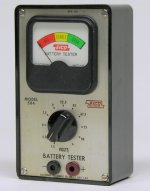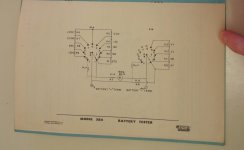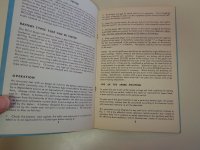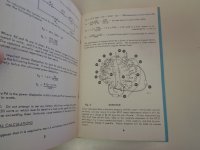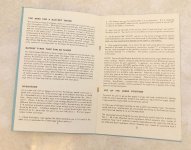I have one of those crappy harbor freight meters and it has a battery test feature.. Curious how it works, a couple quick calcs let me know that it is just a shunt resistor measuring current in milliamps. The resistor is about 360 ohms and this will give a ~4.2 milliamp reading with a fresh battery. This is a pretty low load even for AAA batteries and so the reading doesn't change much from 4ma unless the battery is quite dead.
It occurred to me that I can build my own tester with clip leads and whatever load resistor value I want by measuring voltage instead of current. Clip a lead to each side of the resistor and then clip one lead to each of your voltmeter probes. Measure the battery voltage loaded, then remove one of the clips and measure the battery voltage open circuit.
Neglecting meter loading (40 Megohm input impedance for mine) the measured voltage divided by the resistance of the leads plus the resistor is the current through the circuit. The difference between the open circuit and loaded voltage divided by this current is the internal resistance of the battery
I measured a few deadish alkaline cells around the house with a 72 ohm load and found they had open circuits in the 1.3 V range and loaded voltages a tenth of a volt or so lower and the internal resistance was 2-4 ohms. For a dead 9V I got about a 1.1V drop and 12 ohms.
I used a LSD NiMH that I charged a month or so ago and the drop with a 34.8 ohm load was only 2mV and the internal resistance about 0.05ohms
It's a little fiddly, but the math is simple and easy enough to put in a spreadsheet. The internal resistance seems to be a better predictor of how the cell will work in high drain devices than the open circuit voltage. I had some rayovacs that measured ~1.5V open circuit, but were kind of disappointing in a flashlight. Now I know why - they had a 1.6ohm internal resistance. These measured about 3.9-4ma on the harbor freight meter battery test...
It occurred to me that I can build my own tester with clip leads and whatever load resistor value I want by measuring voltage instead of current. Clip a lead to each side of the resistor and then clip one lead to each of your voltmeter probes. Measure the battery voltage loaded, then remove one of the clips and measure the battery voltage open circuit.
Neglecting meter loading (40 Megohm input impedance for mine) the measured voltage divided by the resistance of the leads plus the resistor is the current through the circuit. The difference between the open circuit and loaded voltage divided by this current is the internal resistance of the battery
I measured a few deadish alkaline cells around the house with a 72 ohm load and found they had open circuits in the 1.3 V range and loaded voltages a tenth of a volt or so lower and the internal resistance was 2-4 ohms. For a dead 9V I got about a 1.1V drop and 12 ohms.
I used a LSD NiMH that I charged a month or so ago and the drop with a 34.8 ohm load was only 2mV and the internal resistance about 0.05ohms
It's a little fiddly, but the math is simple and easy enough to put in a spreadsheet. The internal resistance seems to be a better predictor of how the cell will work in high drain devices than the open circuit voltage. I had some rayovacs that measured ~1.5V open circuit, but were kind of disappointing in a flashlight. Now I know why - they had a 1.6ohm internal resistance. These measured about 3.9-4ma on the harbor freight meter battery test...
For years I have used an Eico type 584 battery tester. It measures voltage under a nominal load and has served me well for ages.
Attachments
I'm using a quite different test : short circuit current. A very basic DMM works well, using 10 A range. For example, good condition NiMH AA cell gives 2.90 A reading or so. Unusable one 2 A, or worse. Good 18650 can be as high as 9 A (very short test !!! beware of fuse protected cells !!!) 5 A cann't work properly.
Comparing various cells with new unused ones permit to establish rules. Hope this helps.
Comparing various cells with new unused ones permit to establish rules. Hope this helps.
I'm using a quite different test : short circuit current. A very basic DMM works well, using 10 A range.
Maybe better to use an analog meter for that, DMM's are slow...
One thing to note in my test - I tested cells loaded first then unloaded on purpose. The full cells were rock steady under load and unloaded. The weak cell voltage would drift down under load and back up open circuit. The amount of drift gives a feel for the cell condition even without doing any math.
For years I have used an Eico type 584 battery tester. It measures voltage under a nominal load and has served me well for ages.
Interesting, uses a ~6.5 ohm shunt (6.8 + 137 parallel to it for meter) for 1.5V batteries, which gives ~230mA. This gives a roughly 9 hour rate of discharge for a AA. Seems to be testing at roughly C/10 then, also with 9V batteries
Interesting schematic, simple enough to cobble together, maybe with a cheap switch like this:
R20307RN02Q C&K Components | Switches | DigiKey
I'm using a quite different test : short circuit current. A very basic DMM works well, using 10 A range. For example, good condition NiMH AA cell gives 2.90 A reading or so. Unusable one 2 A, or worse. Good 18650 can be as high as 9 A (very short test !!! beware of fuse protected cells !!!) 5 A cann't work properly.
I tried this on some AA and AAA (even with my slow digital meter) and it seems to work better than my method, at least with the high load resistances I was using. Shorting AAA alkaline cells I got 1A from ~1.3volt open circuit cells. I got over 6A from some AA alkalines that were 1.5V
Did a few searches and found some interesting data from energizer
http://data.energizer.com/PDFs/BatteryIR.pdf
http://data.energizer.com/PDFs/alkaline_appman.pdf
I'll have to try some smaller resistances and see if they help get a better feel for condition.
- Status
- Not open for further replies.
